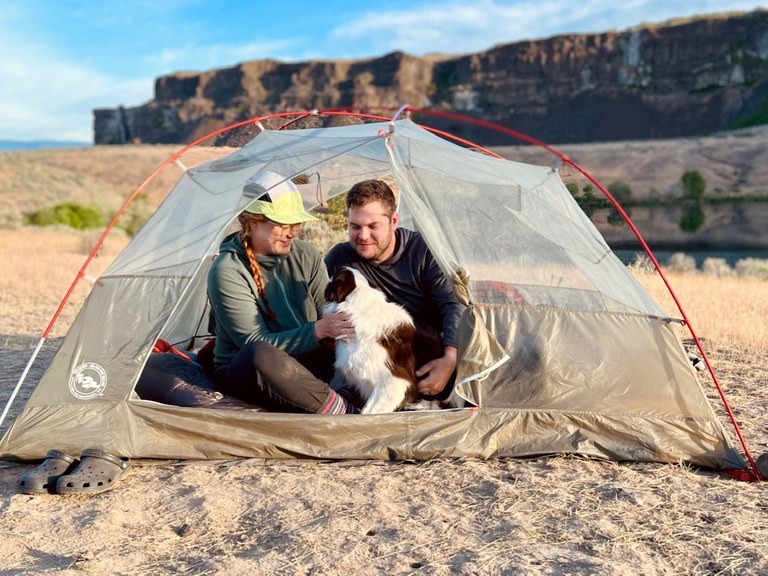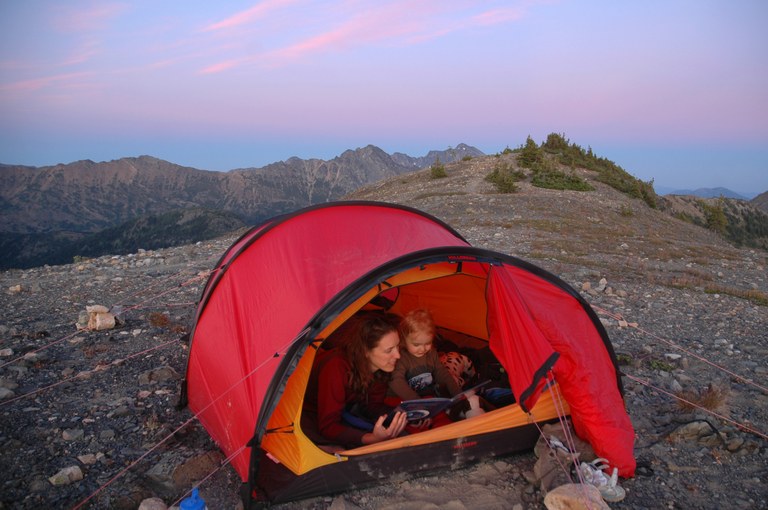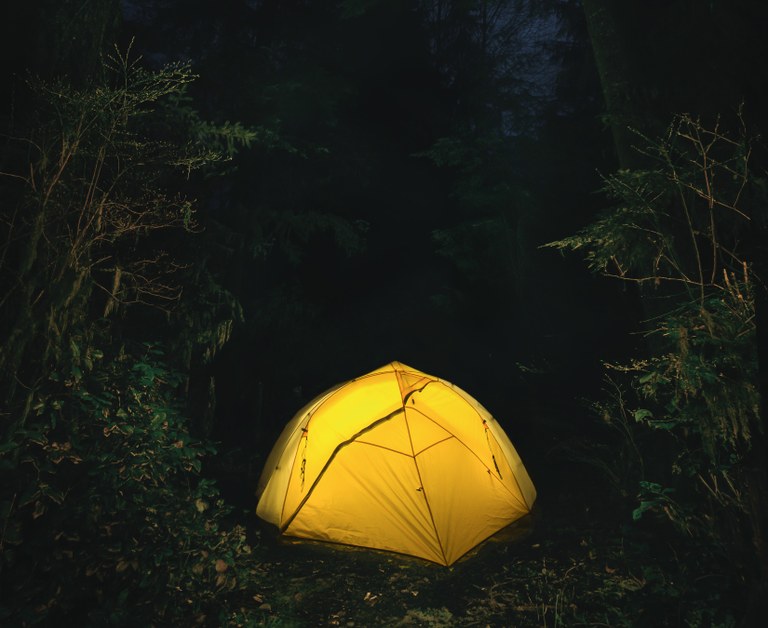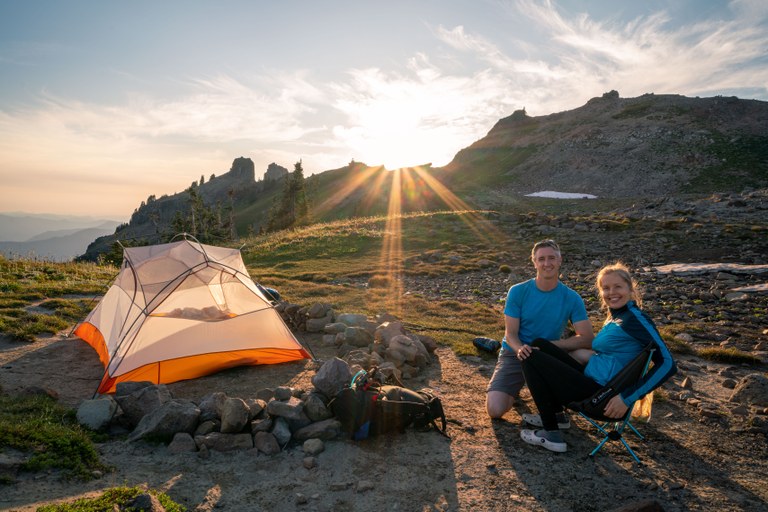 Washington Trails
Association
Washington Trails
Association
Trails for everyone, forever
A shelter is one of the most important pieces of gear you can own, but choices can feel overwhelming. Don't worry — we're here to go over the best options for what's right for you. By Sandra Saathoff
Home is where your tent is! Whether car camping or backpacking, our shelters are our base, the spot where we lay our weary heads for the night. There are so many to choose from — sold by both big-box stores and cottage industry designers — that it can be overwhelming. Not to fear — we’re here to take a look at the major options, so you have a place to start the next time you’re in the market for a shelter.
Tents come in two basic varieties. A free-standing tent can stand up whether it has stakes in the ground or not. A trekking pole tent requires stakes. So, why the difference? It basically comes down to weight.
A free-standing tent includes the tent fabric and poles, which give the tent its structure. Stakes are generally added to keep the tent in place. Free-standing tents come in a variety of sizes and can get quite fancy, with separate rooms and integrated lights for car campers. They can also be minimalist and lightweight for backpackers.
A trekking pole tent, on the other hand, uses a hiker’s trekking poles to help in the pitch. The stakes are an integral component, providing support and tension to keep the fabric in place. This can cut quite a bit of weight from the setup. These tents also come in various sizes and a number of designs. The need for stakes can be challenging, depending on the ground at your campsite. In rocky soil or sandy soil, it can be difficult to keep stakes in the ground. This issue can be mitigated by the use of different types of stakes or well-placed rocks.

Be mindful who will be using a tent before you invest. You, a partner, or even a pet. Photo by Sarah MacGillivray
A single-walled tent is a light, easy-to-put-up tent that, instead of having a separate rainfly, uses its material properties to keep the occupant dry.
Double-walled tents come with a separate rainfly. In addition to the rain-shedding properties, the fly allows for more airflow, meaning less condensation inside the tent.
A hybrid design uses a partial rainfly connected to a single-walled tent. Often the inside walls are mesh netting, allowing for good airflow, while the rainfly also acts as the vestibule or can be rolled up and attached to the tent wall to allow good airflow in dry weather.

Picking the right tent can help you have a more comfortable and easier time on your next night under the stars. Photo by Chris Moorhead
The big three for backpacking are silnylon, silpoly and Dyneema.
Silnylon: Short for silicon-coated nylon, silnylon is used in many light-weight backpacking tents. Its strong suits are durability and waterproofing, though seams do need to be sealed. Silnylon is hydrophilic, meaning it absorbs water in a downpour, but I’ve camped more than one night in an extreme downpour and my silnylon tent has never leaked.
Silpoly: Short for silicon-coated polyester, this fabric is a bit heavier than silnylon and less durable, but it is also less stretchy and more waterproof, being hydrophobic – though honestly, unless you’re camping for a week in springtime on the Olympic Peninsula, you probably won’t have a problem with either option.
You can see the difference in stretch between silnylon and silpoly more readily. The silnylon tent will tend to relax a bit after setup and you will likely need to tighten the cords a bit for a taut pitch, whereas this should not be necessary with the silpoly tent.

If you’re in the market for a new tent, it helps to think carefully about the features you care about most, and what you’re willing to pay for. Photo by Rory McMahon
At times you will see combo tents, with silnylon being used for the floor due to its durability and silpoly used for the sides and rainfly to capitalize on its greater waterproofness.
Dyneema: Dyneema, also called DCF or Cuben Fiber, is a very strong and lightweight fabric that has made its way into backpacking tents as well as all sorts of other gear. The fabric is created by laying out fibers in a grid pattern and then gluing them inside a plastic sandwich, resulting in a fabric that is very strong in line with the fibers. Dyneema is low-stretch and low-sag and is rain resistant, though on the diagonal, where the fibers are weakest, there will be some stretch. Tent-makers continue to tweak designs to maximize the fabric’s strong points. Dyneema is designed for backpackers wanting the lowest weight tents. Like any, there are some cons of the fabric:

Different materials make specific tents better for certain ecosystems. Photo by Ken Marks
Three-season: For most of us, a three-season tent is the only thing we need. It’s designed to protect us from wind and rain, while providing a comfortable shelter for the night. For spring, summer and fall, a three-season tent will likely be exactly what you’re looking for.
Four-season: A four-season tent has a more robust design, heavier material, stronger poles and a separate rainfly (a three-season may or may not have a separate rainfly) and it is built to withstand falling snow. But a four-season tent maybe should be called a one-season tent. The weight from all that extra robustness and the clamminess from a more weather-tight design mean that this tent may not be comfortable in the summer. So if you don’t plan to camp in snow, you’ll likely be fine with a three-season tent.
Doors: Some tents come with one door, some with two. Depending on whether you plan to sleep solo or with a buddy, this can make a difference. Even a single-person tent with two doors can be a luxury, giving you options for setup that can come in handy, including potential for better views.
Ground cloths: Many people consider a ground cloth optional. The benefit is that the ground cloth – also called a footprint – protects the bottom of the tent. If weight is a concern, there are lightweight options, including Tyvek and Polycro if you don’t want a manufacturer’s footprint. Just make sure that the whole thing is under the edge of the tent, or it can funnel rainwater under your tent – no fun, trust me!
Ventilation ports: A person breathes out up to half a pint of moisture overnight. Without good airflow, fully-closed tents can trap condensation, which can then drip on your sleeping bag or quilt. Many tents have small ports or the ability to set the rainfly so it’s not touching the ground. Both options help with condensation by giving air a chance to flow through.
Vestibules: The fabric of most tents covers some ground over the tent door where you can store things like water bottles or your pack and shoes. The size of the vestibule differs by tent design. The vestibule also protects the tent door when entering and exiting in rain, keeping the tent floor drier.
Bathtubs: No, we’re not suggesting that you lug an actual tub into the mountains. A bathtub is the bottom of the tent. Many lightweight tents have sides mostly or almost entirely made of netting. This is great for weight savings and airflow, but not so good for staying dry in the rain. That’s where the bathtub comes in. The nylon floor extends upward a number of inches, keeping you out of the water, should there be any. It’s important to be sure the tent is set up properly, so the bathtub doesn’t sag.
Inside ceiling loops: Many tents come equipped with loops inside, and you can tie some cord to store or air out your smelly socks or even hang a light for reading.

A great tent site isn't just about texture or grade — it's nice to have a view as well. Photo by Aaron Wilson
In the field: A badly placed sharp rock, sharp stick or broken pole can quickly make your home away from home way less cozy. It’s a good idea to have a small stash of repair items. Tenacious Tape can quickly repair a tear, duct tape will stabilize a broken pole, dental floss and a needle can fix a rip in netting. More substantial repairs can be done once you’re home.
At home: It is vital to care for your tents if you want them ready for action when you need them. This means you need to take the time to clean them and set them up to air out after a trip, even if you think they are dry and clean. Moldy tents are no fun. And zippers with dust and dirt in them don’t function well over time. Taking care of rips or tears right after you get home sets you up for a good trip next time. I generally do a decent (but not thorough) cleaning between trips and then a complete clean — dunking the tent in a tub of water to get all the dirt out — at the end of the season.
A shelter is one of the larger expenses associated with adventuring. While we can’t cover everything about tents and shelters, I hope we’ve given you some things to consider if you’re in the market for one. You owe it to yourself to be well-educated, so you’ll be comfortable and cozy in the wild.